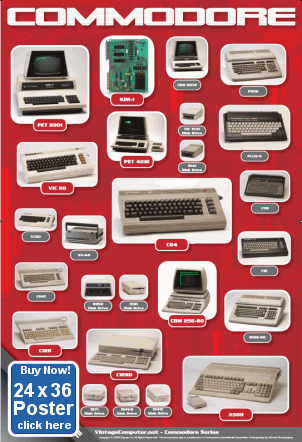 VC Blog | Contact
VC Blog | ContactA History of Computer Music
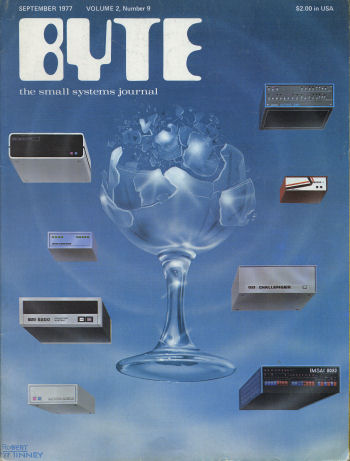
The audio burst from this pantheon of popular early 1977 computers shattering a space goblet. Bablefish that one. hi res Byte September 1977 cover
The first computer sequencers were unable to sample and reproduce the tonal quality of analog instruments effectively due to weak computing power. Over time this ability improved as computing power improved. This is only part of the story. Early pioneers (1960's) of computer music also discovered ways to generate music using complex mathematical algorithms impractical for humans playing instruments. The core of this revolution was software. Timed loops, randomization, and stored data made previously impractical explorations in scale, pitch, tone, meter and volume possible for the first time. Modern computer music still employs techniques developed in the 1960's and 1970's.
MUSIC OF A SORT
May 1975 People's Computer CompanyBy Steve Dompier
One of the first documented instances of computer music generated by a microcomputer appeared in the May 1975 Peoples Computer Company publication. Borrowing from the same techniques used to output music from the IBM 1401 and Digital PDP 1 computers, Steve Dompier discovered how to send computerized music from his Altair 8800 to an AM radio receiver for playback. This article was later republished in February 1976 Dr. Dobbs Journal of Computer Calisthenics & Orthodontia and shows the reader how to toggle instructions using the Altair front panel and "record" simple songs. The music is "broadcast" by the computer whirring quickly through the machine instructions and producing harmonic interference that can be picked up by an AM radio in the form of tone pulses. The program code simply times pulses at selected frequencies that represent notes in the scale, C-D-E-F-G-A-B and the sharp/flat tones. There is nothing stopping the computer from generating tones outside of the western or asian scales however - a new set of possibilities.Read entire article
You Tube video of Altair playing Fool on the Hill by the Beatles
AN INSIDER'S GUIDE TO COMPUTER MUSIC RECORDINGS
Creative Computing March/April 1977By John Selleck
".. The story of computer music begins at Bell Telephone Laboratories with the
efforts of Max Matthews and others. In the late 60's the essential characteristics
of sound synthesis programs were established and most subsequent improvements
to this early work have been in the nature of user (composer) oriented modifications.
Vladimir Ussachevsky, an undisputed master of the electronic medium, produced
a computer piece as early as 1968 using preliminary efforts at digital sound
synthesis made by Jean Claude Risset (known for his work in brass-instrument
tone synthesis) and F.R. Moore, the resulting work titled : Computer Piece
No. 1.. .." More...
New Horizons for Microcomputer Music
Creative Computing March/April 1977By Malcolm Wright of Solid State Music
"..imagine the future composer being able to write and edit pieces of music for a whole orchestra and being able to play the music instantly after completion by typing RUN on his computer!" More...
A Sampling of Techniques for Computer Performance of Music
Byte September 1977By Hal Chamberlin
Download this article for a thorough introduction to the foundations of 8-bit computer music. Topics include analog to digital conversion, machine language data tables for frequency, and equations for pitch and duration. This article also contains a number of descriptive examples of what was happening in computer music at the time.".. Recently, specialized music peripherals have appeared, usually oriented toward the S-100 (Altair) bus. In some cases these are digital equivalents of analog modules of similar function. For example, a variable frequency oscillator may be implemented using a divide-by-N counter driven by a crystal clock. The output frequency is determined by the value of N loaded into a register in the device, much as a control voltage affects a voltage controlled oscillator. Such an approach bypasses the frequency drift problems and interfacing expense of analog modules. The biggest advantage, however, is availability of advanced functions not feasible with analog modules.
One of these is a programmable waveform. A small memory in the peripheral holds the waveform (either as individual sample values or Fourier coefficients), which can be changed by writing in a new wave form under program control. Another advantage is that time multiplexing of the logic is usually possible. This means that one set of logic may simulate the function of several digital oscillators simultaneously, thus reducing the per oscillator cost substantially. .."
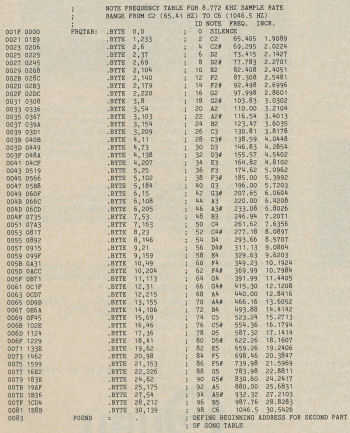
The Note Frequency Table used with the KIM-1 and other early 6502 computers. Click image for larger version.
Commodore Launches a Winner
Microcomputing March 1983By Robert W. Baker
Although not the first Commodore to use the SID chip for audio, the C-64 made
it famous. By 1983 a complete programmable synthesizer was found in a single
chip. "..The Commodore-64 is equipped with one of the most sophisticated electronic music synthesizers available on any computer: the MOS 6581 Sound Interface Device (SID) chip. The SID provides three separate sound-generating sections, or "voices." Each voice is fully programmable for tone, waveform, Attack/Decay/Sustain/Release (ADSR), filtering and modulation. The SID is capable of providing a wide range of control over pitch (frequency), tone color (harmonic content) and dynamics (volume). The three synthesizer voices can be used independently or together to create more complex sounds. Each voice consists of a tone oscillator, waveform generator, envelope generator and amplitude modulator..." Download this article
Can't Get Enough of Portables?
The Panasonic Senior Partner
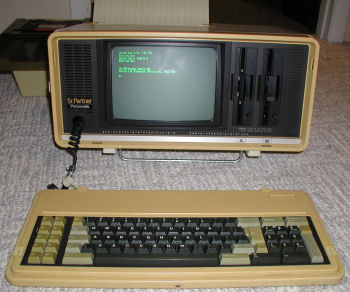
The Panasonic Senior Partner is an attractive early Japanese IBM clone with a built-in printer. This model probably came with MS DOS 2.1
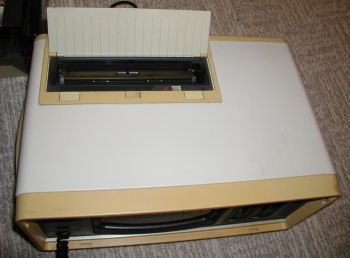
The built-in printer makes this a useful portable for word processing.
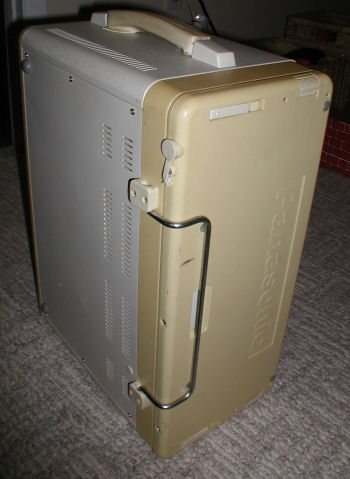
But will this fit in the luggage compartment?
Comments and pictures
Donner 3500 - an early portable computer
Pushing the exploration of portable computing one giant step farther (for me), here is a quick glimpse of the Donner 3500...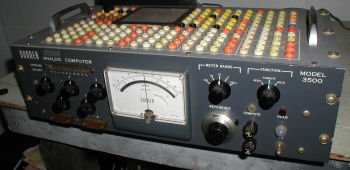
The 1959 Donner 3500 portable analog computer. Click for larger image.
My copy of the instruction manual was published in 1960, after Systron merged with Donner to form Systron-Donner Corporation. The manual depicts a Model 3500 with leather handles on the sides. The computer I have has metal handles on top, and I am unsure if this means it's an earlier model made before the merger or if the handles were added by the owner. Because they are symmetrical, I'd like to believe that they are factory/original handles. Also, this computer's serial number is 107, which also indicates an earlier version. Serial numbers can be deceiving however.
The computer id plate on the back of my 3500 says "Donner Scientific Company".
I do not have the "3571 Potentiometer Strip" option installed to the top back of the 3500, indicating that this computer may have been used with an external control device or oscilloscope.
Pictures and Latest News
Lower Bucks County C64 User Group Archive Available
I archived the entire collection of diskettes from the Lower Bucks County C64 User Group, a club based near where MOS and Commodore once operated in Pennsylvania. This archive is a glimpse into a pre-WWW electronic community. When I am done the entire collection of disks, starting from #16 (Jan 1986) through December 1991 will be available. I have uploaded so far the first three years. To use these disks, you will need a way to download and extract D64 (C-64 disk images). If anyone has disks 1-15 I would greatly appreciate D64 copies if they're available.LUG also had a companion BBS, presumably where this archive would have been available. I am unsure if anyone in our group was a member of LUG back then...anyone?
The disk archive also contains a large number of Compute! and Compute! Gazette disks which I will also upload. These disk images can be found elsewhere now, but I will upload these in the event that there were customizations specific to this group.
Because these were public domain disks, I have not protected the directory, and you don't need an account on my site to download the files.
The archive starts with disk M016. I am unsure if the earlier disks still exist.
LUG Archive
Classic Computing Items for Sale:
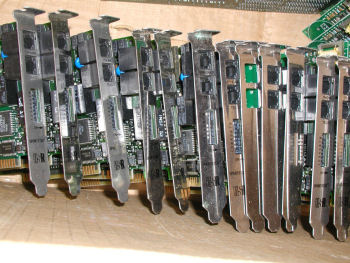
| CBM Commodore B Series Software (B-128 / CBM 700) | ||
| Superscript II Word Processor | $29.99 | |
| Superbase Database Manager | $29.99 | |
| Commodore Advanced Business Systems (CABS) Acccounting Suite: Accounts Payable, Order Entry, Accounts Receivable, General Ledger (4 binders) | $29.99 | |
| More CBM Commodore Items | ||
| Commodore B-128/700 Programmer's Reference Guide - Protecto - Everything you need to know about the B line! | SOLD OUT | |
| B Series Commodore Users Guide - View Image | $39.99 | |
| Commodore Users Guide Series 8000 | $39.99 | |
| Commodore BASIC Users Refence Manual Version 4.0 | SOLD OUT | |
| Commodore CBM Expansion Memory Board 64K Expansion Kit for PET 8032 (NOS) | SOLD OUT | |
| Commodore PET Keyboard (NOS) for 2001 -N, 3000, 4000 Series | SOLD OUT | |
| Other Commodore CBM Power supplies, software, parts, etc. | Contact Me | |
| Tandy Items | ||
| Aeoromp Double Density Controller for TRS 80 Model 1 Expansion Unit (NOS)- details | SOLD OUT | |
| Model III / Model 4 (non-gate array only) RS-232 KITS details | SOLD OUT | |
| Model III / Model 4 (non-gate array only) RS-232 boards only | SOLD OUT | |
| Model III Aerocomp Diskdrive controller | $39.99 (free US Ship) | |
| Looking for Something Else? | ||
| Please check here first with special requests for Commodore, IBM, Tandy, Atari, TI, Apple computers, parts, components, and software. I have systems plus zounds of miscellaneous items for sale or trade. | ||
On the Work Bench Summer 2009
Selected recent blog articles with extra content...See my Vintage Computer Blog to search for latest articles, or post your questions.Commodore P500 (aka C128-40)
The Commodore P500, also known as the C128-40, was the first Commodore model with a SID chip. Can you name the other 10? Click Here if you're stumped.
Converting a P500 from PAL to NTSC:
A pro solderer I'm not, but you can use these step by step images to do the conversion:
First swap the PAL VIC-II chip for the NTSC version (MOS 6569 for a 6567). The VIC-II chip is the one with the heatsink compound on the id plate. Click Image for detail view.
Next replace the PAL 17.73447 KDS crystal at Y1 for the 14.31818 KDS NTSC equivalent
Last, change the jumper from LK4 to LK5.
The Commodore P500 pictured here still uses 220V (English) current and the UART is still European, but the video has been successfully converted to NTSC.
More How To:Blog Post for pictures and details
Processor Tech SOL 20 Terminal Computer
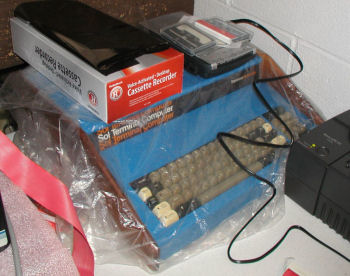
The Processor Technologies SOL-20 Computer
For this computer the DC Voltage is consistently below 5V, something is shorting out. To diagnose exactly where the short(s) exist, a volt meter was applied to known 5V points on the motherboard, and the reading is consistently 4.72 volts, which is below the acceptable threshold.
The latest on this project...
Altair 8800 Update
For the past year or so Dan Roganti has been restoring an Altair 8800 S/N 220744K. By participating in the restoration process I have learned a whole lot and I am starting to apply this knowledge to this and other projects.For starters, I am going to test every electrical component and compare with another 8800, same model. I want to try to get them both running by comparing and contrasting how they work. This is a good approach for the amateur, if you can find another working system and you know how to use a voltmeter and soldering iron.
Anyway, As I was testing the caps in the back by the power supply I found that one of the caps is about to go:
Image of Altair 8800 16V 3300 uf capacitor with a bubble forming on the plus side. It's the orange mass. For now it still works, but it must be replaced immediately. Click on image for larger view.
Read More...
Televideo PM/286
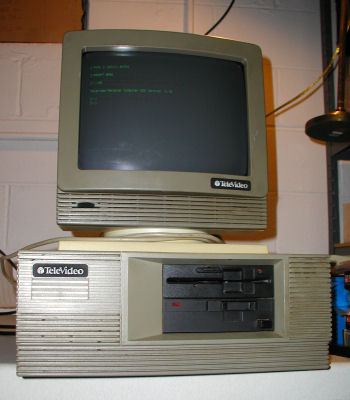
The Televideo PM/286 Computer with 8 user ports. The PM/286 is a near IBM AT clone with notable features such as a 286 processor with external switch to change from 8 mhz to 6 mhz (should you be feeling a bit slow that day) and cassette port for backup storage.
This model has a high resolution color CGA card, a Novell controller and a 8-port user controller.
This system has a bad battery and the motherboard was in pretty bad condition. I cleaned it up, and I found that I need to replace the battery. I have a complete batch of the system software, and I would like next to return this system to original condition. The manuals make it clear that this is an MS DOS based system. I put the computer in the same class as the early TI Professional "almost IBM compatibles". I wonder if it is possible to run CP/M or some variant, obviously with the 8 user ports this system is made to be a multi-user system and there may be a way to move files from older Televideo boxes using CP/M or MP/M to this machine. It may simply be that one should use the RS232 port for that. There is more to uncover here, but time is limited.
Here is an example of a 286 offshoot computer by Televideo that puts the 286 into historical perspective. Before IBM the standard product for small business computers was a CP/M - Z80 product with multi-user capability. Basically a large, heavy mini computer replacement with lots of terminal ports, plus various interface ports. Led by IBM, i8088 and later i80286 based systems began to crowd out the Z80 CP/M systems. The driver of this push was software. The 16-bit software was becoming more popular than the 8-bit CP/M driven stuff. Businesses especially did not change their preferences overnight, but the curtain was closing on the older systems. Companies like Tandy, Televideo, CompuPro, Texas Instruments, etc. were forced to adapt their product line to include systems that were compatible with Lotus 1-2-3 and MS DOS in order to stay competitive, so towards the end of their existence released i8088 and i80286 systems for business.
Pictures and Comments
Comparing Altair 680 motherboards and Another Hacking Weekend
I have two versions of the Altair 680b. The left unit has the older round toggle switches, the right has the newer flat switches. It turns out that there are other differences as well. Click for larger image.
First of all the situation on the Altair 680 with the flat paddles and 1-6 motherboard - it's not working.. Specifically it has a DC voltage problem. Should have +5 on pins 15, 12, 13, 23 of each 1702 PROM. Also should have -9 to pins 16 and 24. I was able to confirm that the ACIA PROM is OK, and that the power supply itself is OK. Despite the voltate issues, there is some ability to read RAM contents from 0000. The other 680 seems to be OK and I can successfully run VTL-2 from PROM. It's useful to have two for compare and contrast purposes.
Took a look at the transistor near Q1 and zener diode to see if it's correctly helping set voltage ..
I need to replace transistor Q1's associated SZ 10.9V Zener Diode and the nearby voltage regulator. Tried a 5.1 Zener from Radio Shack, a little low to power the PROMS.
This motherboard is a 1-6 (not a 1-6x like my other Altair 680).
Project Details and Pictures
Vintage Computer Workshop...
Herb Johnson helped me on the Altair 680 project, and he provided detailed analysis vs. my shot gun repair approach. In fact we two attended Mike Loewen's Vintage Computer Workshop, June 2009. I was also able with help to restore a Zenith Z-19, and test tubes in my Donner 3500.
Video of Exatron Stringy Floppy
I made a quick video of the TRS 80 Model 1 with "custom" desk for two Exatron Stringy Floppy drives (drive 0 and 1). In the video I load the demo program for the drive.http://www.youtube.com/watch?v=EBfNy021K2Q
While you're here, here is the command to load the first program on the 2nd drive after loading the Stringy Floppy ROM from the SYSTEM prompt ( * ):
@#1LOAD1 [return]
@ = enter a command
#1 = change default drive to 1
LOAD = load program on wafer
1 = first program on wafer
Archiving Wafers to WAV (Thanks Terry Stewart of New Zealand)
Digital (DEC) PDP 11/05 Assembly
Ted Nelson speaks quite highly of the Digital PDP 11 series in his book Computer Lib / Dream Machines.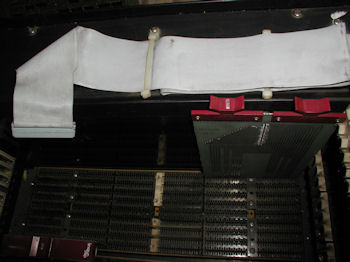
Picture of the card cage and front panel (detached). Click image for hi res version.
The only thing that prevented DEC from launching the PC revolution three years earlier was price, in my opinion. All of the other ingredients were there for a fine PC. The PDP 11/05 was the OEM version of the PDP 11/10, so you find all kinds of variations of this system sometimes paired with the DEC GT40 Graphic Display Terminal.
PDP 11/05 card guide labels.
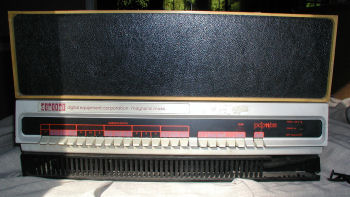
Picture of the assembled system. The core memory is functional, and I can read/write to the full 4K without issues.
Pictures and Comments
Past Issues:
Before we switched over to a blog format, past page archives here:
Vintage Computer Festival East 3.0 June 2006
Commodore B Series Prototypes July 2006
VOLSCAN - The first desktop computer with a GUI? Oct 2006
ROBOTS! - Will Robots Take Over? Nov 2006
Magnavox Mystery - a Computer, or? Jan 2007
The 1973 Williams Paddle Ball Arcade Computer Game Feb 2007
The Sperry UNIVAC 1219 Military Computer May 2007
VCF East 2007 - PET 30th Anniversary June/July 2007
The Electronic Brain August 2007
Community Memory and The People's Computer Company October 2007
Charles Babbage's Calculating Machine December 2007
Vintage Computing - A 1983 Perspective February 2008
Laptops and Portables May 2008
From Giant Brains to Hobby Computers - 1957 to 1977 August 2008
Historic Computer Magazines November 2008
World's Smallest Electronic Brain - Simon (1950) December 2008 - Feb 2009
Free Program Listings Spring 2009
Computer Music Summer 2009
Popular Electronics Jan/Feb 1975 - Altair 8800 Fall 2009
Early Microcomputer Mass Storage Summer 2010
